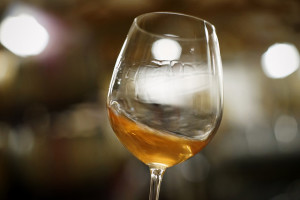Hello readers! I am currently on my maternity leave spending some quality time (and little sleep) with my brand new son! Enjoy this guest post from today’s featured author!
The following is a guest post by Noelle Allen. Noelle is currently working through WSET Level 4 and starting her thesis at the Wine School of Philadelphia, where she also teaches private Wine 101 classes. Her blog is winelala.com, which is in the process of being relaunched in the near future.
We all know that the same grapes produce very different wines, depending on a number of factors including country of origin, vintage, weather and growing conditions, and production techniques, to name a few. Grape taste spectrums are mind blowing.
Early in my wine career, I generally thought of Pinot Grigio / Pinot Gris (they’re the same grape; ‘Grigio’ is Italian and ‘Gris’ is French and they both mean ‘gray’ — pinot means pinecone — but the two styles can be very different) as maybe zesty and florally, acidic and flinty, but overall, just, really… unexciting. Flat and thin. I had come to that conclusion even before hearing other wine nerds speak dismissively of the little gray pine cone.

Photo by Flickr user Alan Levine
And then I was presented with a bottle of Pinot Grigio by a wonderful producer in northeast Italy. I had no idea that I was about to go on a little journey.
The wine tumbled into the glass, and it even sounded good. No glugs or disjointment. It simply swirled around then settled in like a pro. It was a clear and bright lemon yellow. The aroma made itself known almost immediately, and what an amazing combination. Banana, pear, and almond. The inhale was gorgeous.
On the tongue, the wine was full bodied and citrusy, – full bodied, hmmm – and had a long, minerally finish. The weight and balance were absolutely splendid. To put it in the vernacular of my maturity level during those times, the wine was amazeballs. Any notions of flatness or thinness drained away, just like the wine from my glass and eventually the bottle, as my friends and I happily talked and sipped.
Afterward, intrigued, I visited the producer’s website. After digging a bit, and even ambitiously translating Italian into English, I came across the technical description that included a ‘Dry Extract’ count. Specific to this wine, it was 19.8 grams per liter. What is dry extract? And is 19.8 g/l a lot or a little or normal?
Quite simply, dry extracts (DE) are the powdery solids that are left over after taking away the sugar, water, ethanol, and acid from wine, all of which are major components. (To separate out these items, you will likely need a centrifuge, so good luck with that if you try it on your own.) Dry extracts are made up of minerals and trace elements such as potassium, phosphorus, iron, calcium, and magnesium; all of which come from the soil in which the vine grows and affect the biology of the plant and its resulting fruit.
The grapes for this particular wine had grown in loam, a soil type made of silt, clay, and sand, all of which are collections of minerals that produce and capture different quantities of given elements. While some argue that minerals do not have aromas, given that they are inorganic and non-volatile, others say that they do give off definite sensory perceptions, whether through weight, aroma, flavor, texture, or some synergistic

Photo by Flickr user Jim Fischer
combination. It can all get very deep and very interesting given that the ‘minerality’ in wine is so often discussed and accounted for in tasting notes. The Wine and Spirits Education Trust (WSET) even teaches it as a ‘secondary’ flavor and aroma term.
The higher the dry extract count, the heavier the wine is. The normal range of dry extract grams per liter for white wine is 15 to 20, and for reds, it’s 20 to 30, although you can find wines outside these ranges. The dry extract count is not usually readily available on a bottle, and it doesn’t need to be, because ‘light’, ‘medium’, or ‘full bodied’, descriptors usually are in place if the label contains tasting notes. DE quantities can usually found in the technical sheets along with the alcohol, total acid, and residual sugar levels.
But having the ability to translate the numeric data is not only pretty fun and impressive, it can really put a framework around an abstract, as in this case, where ‘full bodied’ was calculated to the tenth decimal point.
So what are your thoughts? Do you check DE levels? Can you smell/taste minerality? Can you believe that is a topic that lends itself to arguments?
